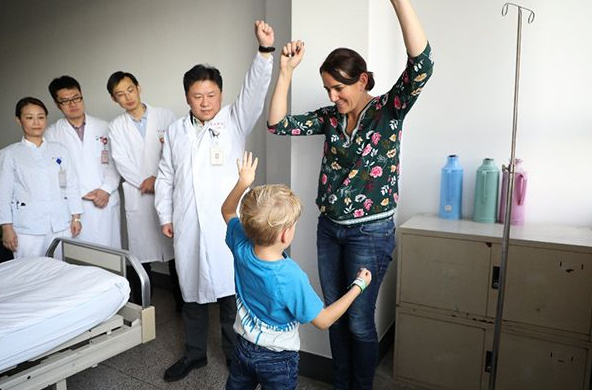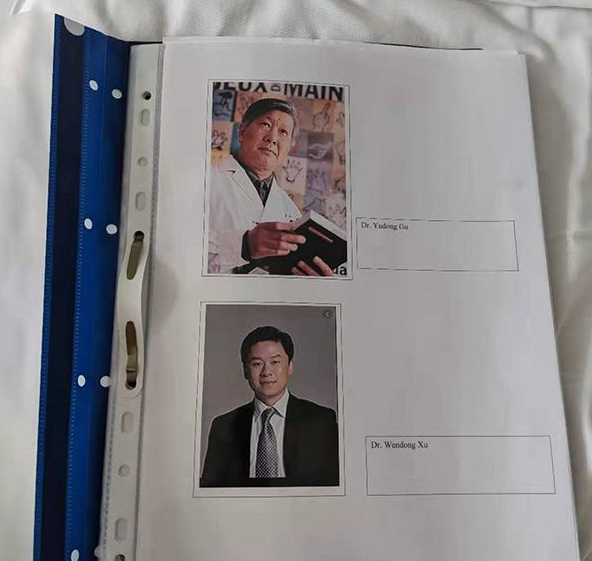Sandra, a mother from Germany, found hope for her 5-year-old son, Felix, in a groundbreaking medical paper published by Chinese doctors.
The Desperate Search for a Cure
Felix, Sandra’s son, was diagnosed with cerebral palsy shortly after birth due to oxygen deprivation caused by a nuchal cord. The condition resulted in spastic hemiplegia, affecting his left arm and leg. His left arm was mildly flexed at the elbow and wrist, and his thumb was adducted, causing a complete loss of gripping ability in his left hand. This made his daily life heavily dependent on Sandra’s dedicated care.
Despite extensive efforts in Germany to find a suitable treatment, Sandra could only secure conservative rehabilitation and botulinum toxin injections, which showed minimal improvement. With a background in journalism, she turned her attention to professional medical publications and conducted thorough research. It was during this search that she discovered a paper published in the New England Journal of Medicine by Chinese doctors Gu Yudong and Xu Wendong titled “Clinical Trial of Contralateral Cervical Nerve Transfer for Upper Limb Spastic Paralysis.”
A Ray of Hope from China
Sandra was overjoyed to read about the Contralateral Cervical Nerve Transfer (CCNT) surgery, which promised high safety, efficacy, and positive outcomes for patients like Felix. However, she found that no hospitals in Germany were equipped to perform the surgery independently, and it was not even listed on the health insurance plan. Undeterred, Sandra contacted the authors of a review article that further explained the benefits of the surgery. The review’s authors recommended two options: seek treatment in the United States, where trained doctors were available, or go directly to the pioneers of the technique—Professor Gu Yudong and Professor Xu Wendong at Huashan Hospital, affiliated with Fudan University.
Determined to give her son the best chance, Sandra began extensively researching the CCNT surgery. She sent an email to Professor Xu Wendong, attaching all of Felix’s medical history and hoping for a positive response. The local Chinese community in Germany also rallied to help Sandra, assisting in booking appointments and facilitating communication with the hospital.
Preparing for the Journey
After a thorough video consultation, Professor Xu and Associate Professor Shen Yundong confirmed that Felix was a suitable candidate for the surgery. Sandra immediately started planning the trip to China, bringing with her a stack of papers and reviews she had meticulously studied. “I’ve done all the homework I could. This is a Chinese innovation, and I want the surgery to be performed here,” she said.
On November 11, 2019, Sandra and Felix arrived in Shanghai. Despite the jet lag, they made their way to Huashan Hospital without delay. The hospital staff assisted them efficiently, and Felix was admitted and prepared for the surgery.
The Life-Changing Surgery
On the morning of November 14, 2019, at 9:30 AM, the surgery began. Professor Xu Wendong led the operation, supported by Associate Professor Shen Yundong and attending physician Li Tie. With the help of the anesthesiology and nursing teams, the surgery successfully transferred Felix’s healthy side C7 nerve through a special pathway in the neck to the affected side, where it was meticulously reconnected under a microscope using sutures finer than a human hair. The entire procedure took about three hours, with only 25 milliliters of blood loss, and was deemed a resounding success.

Recovery and New Beginnings
Under the attentive care of the ward’s medical team, Felix’s recovery was steady. By the second postoperative day, he was already able to stand, and his left arm’s muscle tone had significantly decreased. On the fourth day, Sandra excitedly reported to the doctors that Felix could voluntarily extend his previously flexed left arm, and his wrist and fingers were beginning to move more freely.
A week after the surgery, Professor Xu’s team provided Felix with a personalized rehabilitation plan, including a set of exercises developed by the hospital. They emphasized the importance of continued rehabilitation back in Germany to further alleviate spasticity, promote nerve regeneration, and restore limb function. Sandra was reassured and grateful, noting, “When we return home, I will share this experience in writing to help others who might be in the same situation.”
A Symbol of International Cooperation
“Success was expected, but the journey of a German mother seeking treatment in China exemplifies a precious friendship between our two countries,” Professor Xu stated. Huashan Hospital, supported by the National Natural Science Foundation of China and the Chinese-German Science Center, has been actively collaborating with German institutions such as the Rechts der Isar Hospital of the Technical University of Munich, fostering a spirit of international cooperation.
For over three decades, the hand surgery team at Huashan Hospital has been at the forefront of using nerve transfer techniques to treat various forms of limb dysfunction. In 1986, Professor Gu Yudong innovated the “Contralateral Cervical Nerve Transfer for Brachial Plexus Injury,” which Professor Xu Wendong later advanced by demonstrating that one hemisphere of the brain could simultaneously control both upper limbs.
Sandra’s journey to China for Felix’s surgery not only represents a personal triumph but also highlights the growing global influence and recognition of Chinese medical innovations. Her story is a testament to the power of international collaboration in advancing medical science and improving lives.


